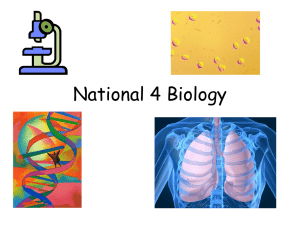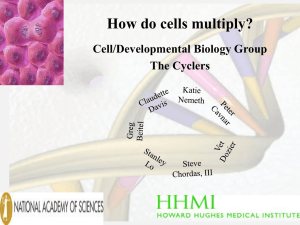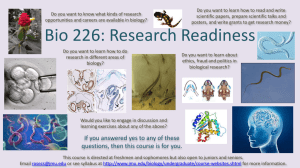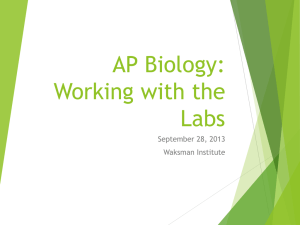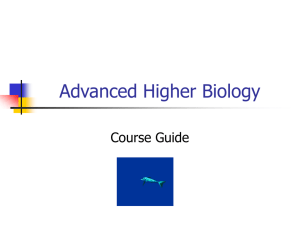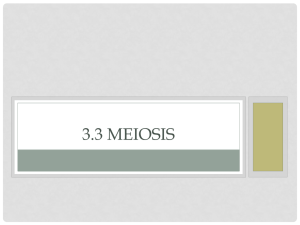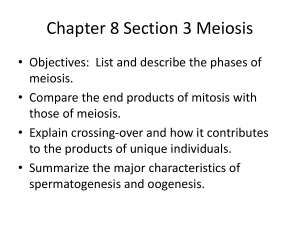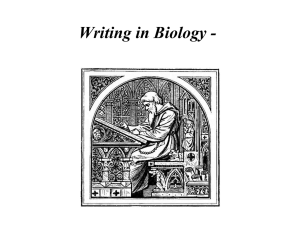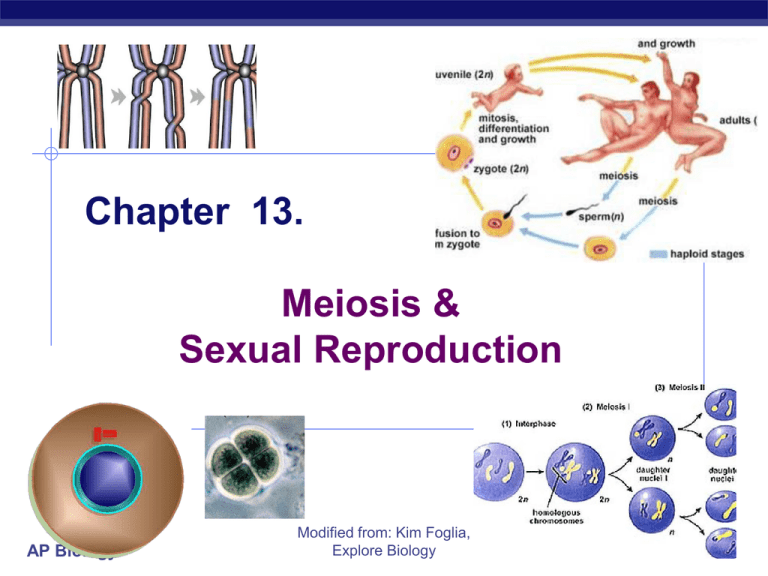
Chapter 13.
Meiosis &
Sexual Reproduction
AP Biology
Modified from: Kim Foglia,
Explore Biology
How about the rest of us?
What if a complex multicellular organism
(like us) wants to reproduce?
joining of egg + sperm
Do we make egg & sperm by mitosis?
46
egg
AP Biology
+
46
92
sperm
zygote
Human female karyotype
AP Biology
Human male karyotype
AP Biology
How do we make sperm & eggs?
reduce 46 chromosomes 23 chromosomes
half the number of chromosomes
23
46
meiosis
23
46
egg
23
46
23
sperm
AP Biology
fertilization
Meiosis: production of gametes
Alternating processes,
alternating stages
chromosome number
must be reduced
diploid haploid
2n n
humans: 46 23
meiosis reduces
chromosome number
fertilization restores
chromosome number
haploid diploid
AP Biology
n 2n
Homologous chromosomes
Paired chromosomes
both chromosomes of a pair carry genes
control same inherited characters
homologous = same information
diploid
2n
AP Biology
homologous
chromosomes
double stranded
homologous chromosomes
Double division
of meiosis
DNA replication
1st division of
meiosis separates
homologous pairs
2nd division of
meiosis separates
sister chromatids
AP Biology
Steps of meiosis
Meiosis 1
interphase
prophase 1
metaphase 1
anaphase 1
telophase 1
Meiosis 2
prophase 2
metaphase 2
anaphase 2
telophase 2
AP Biology
1st division of
meiosis separates
homologous pairs
(2n 1n)
2nd division of
meiosis separates
sister chromatids
(1n 1n)
* just like mitosis *
AP Biology
AP Biology
Crossing over
During Prophase 1
homologous pairs swap
pieces of chromosome
sister chromatids intertwine
crossing over
tetrad
AP Biology
synapsis
Crossing over
3 steps
What are the
advantages of
sexual reproduction?
cross over
breakage of DNA
re-fusing of DNA
New combinations of traits
AP Biology
Genetic variation
Meiosis & crossing over introduce
great genetic variation to population
AP Biology
drives evolution
The value of meiosis
Meiosis introduces genetic variation
gametes of offspring do not have same
genes as gametes from parents
genetic recombination
random assortment in humans produces 223
(8,388,608) different combinations
Mom
APfrom
Biology
from Dad
new gametes
made by offspring
And more variation…
Crossing over
AP Biology
creates completely new
combinations of traits
in next generation
Random fertilization
Any 2 parents will produce a zygote
with over 70 trillion (223 x 223) diploid
combinations
AP Biology
Sources of genetic variability
Genetic variability in sexual reproduction
independent assortment
homologous chromosomes in Meiosis 1
crossing over
between homologous chromosomes in
prophase 1
random fertilization
random ovum fertilized by a random sperm
AP Biology
metaphase1
Sexual reproduction creates variability
Sexual reproduction allows us to maintain both
genetic similarity & differences.
Michael & Kirk
Douglas
AP Biology
Baldwin brothers
Martin & Charlie Sheen, Emilio Estevez
Cell A has 4 chromosomes and Cell D has 2
chromosomes. What process created Cell D?
1. Mitosis
2. Asexual
3.
4.
Reproduction
Fusion
Meiosis
AP Biology
Cel
lA
Cel
lB
Cel
lC
Cel
lD
1
0
Cell A is considered _______ while Cell D is
considered ________.
1.
2.
3.
4.
Haploid; Diploid
Tetrad; Diploid
Diploid; Haploid
Homologous; Haploid
Cel
lA
0%
1
AP Biology
0%
0%
2
3
Cel
lB
Cel
lC
Cel
lD
0%
4
1
0
Cell A is considered _______ while
Cell D is considered ________.
A. somatic cell;
gamete
B. gamete; somatic
cell
C. stem cell; somatic
cell
D. stem cell; gamete
0%
et
e
m
at
st
e
m
ce
ll;
so
m
ce
ll;
m
st
e
3
0
ga
ic
ic
at
so
m
et
e;
ga
m
0%
ce
ll
ce
et
e
m
ga
l;
ce
l
at
ic
so
m
AP Biology
0%
ll
0%
How can we best describe the diagram
below?
1.
2.
3.
4.
Two sister chromatids
Homologous chromosomes
One replicated chromosome
Haploid chromsomes
AP Biology
0%
1
0%
2
0%
3
0%
4
1
0
What process is best demonstrated by the
diagram below?
1.
2.
3.
4.
Anaphase I
Segregation of alleles
Crossing over
Independent assortment
AP Biology
0%
1
0%
2
0%
3
0%
4
1
0
Which of the following leads to
genetic variation during meiosis?
A.Crossing Over
B.DNA replication
C.Independent assortment
spindle formation
1. All D.Mitotic
of the above (A, B, C,
2.
3.
4.
5.
D)
A&B
A&D
A, B, & D
A&C
AP Biology
0%
1
0%
0%
2
3
0%
0%
4
5
1
0
Mitosis vs. Meiosis
Mitosis
AP Biology
1 division
daughter cells
genetically identical
to parent cell
produces 2 cells
2n 2n
produces cells for
growth & repair
no crossing over
Meiosis
2 divisions
daughter cells
genetically different
from parent
produces 4 cells
2n 1n
produces gametes
crossing over
Mitosis vs. Meiosis
AP Biology
Changes in Chromosomes
Number
Euploidy = correct # of chromosomes
Aneuploidy = a change in
chromosomes number due to nondisjunction during meiosis
Monosomy- only 1 copy of an individual
chromosome
Trisomy- 3 copies of an individual
chromosome
AP Biology
Non-disjuction
Primary nondisjuction = Meiosis I
Secondary nondisjuction = Meiosis II
AP Biology
Trisomy 21 : Down Syndrome
Delayed mental and social skills
Decreased muscle tone at birth
Asymmetrical or odd-shaped skull
Small skull
Small mouth with protruding tongue
Broad short hands
Increased risk of developing
Leukemia and Alzheimer’s later in life
AP Biology
AP Biology
Trisomy 18 : Edward’s Syndrome
Most children die in the first year of life, some have lived 10
years
Growth deficiency
Feeding difficulties
Breathing difficulties
Developmental delays
Mental Retardation
Overlapped, flexed fingers
Webbing of the second and third toes
Clubfeet
Structural heart defects at birth
AP Biology
Trisomy 13 : Patau Syndrome
Mental retardation, severe
Seizures
Small head
Scalp defects
Cleft lip and/or palate
Eyes close set (hypotelorism) –may fuse
Extra digits (polydactyl)
Hernias
Undescended testicle
Children die in the first year of life
AP Biology
Karyotype
A visual display of the chromosomes arranged by
size, shape, and banding pattern
Used to identify aneuploid conditions
AP Biology
Procedure: Amniocentesis and
Karyotyping
AP Biology
Karyotyping
AP Biology
Changes in Sex Chromosome #
Turners Syndrome (XO) – missing Barr Body
Kleinfelter’s Syndrome (XXY)
Swyer Syndrome (XY female)
La Chapelle Syndrome (XX male)
Poly-X Females (XXX, XXXX)
Jacob’s Syndrome (XYY males)
-SRY gene (located on short arm of Y chromosome)
-hormone= testis-determining factor
-Barr Body – Inactive X chromosome (XX)
AP Biology
Chromosomal Mutations
AP Biology
Deletion Syndromes
Williams Syndrome (deletion of a piece
of chromosome 7)
Cri du chat (cat’s cry) (deletion of a
piece of chromosome 5)
AP Biology
Translocation Syndromes
Alagille syndrome – Chromosomes 2
and 20 exchange segments
Cancers
Chronic myelogenous leukemia (2 and
9)
Burkitt lymphoma (8 and 14)
AP Biology
What are the
DISadvantages of
sexual reproduction?
Any Questions??
AP Biology

